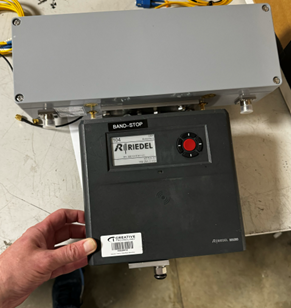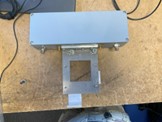A solution for overcoming interference with Bolero 1.9Ghz in outdoor settings.
Background
Bolero uses an operating frequency in the DECT (Digital Enhanced Cordless Telecommunications) band of the electromagnetic spectrum at approximately 1.9GHz.
This frequency is sensitive to interference from 5G mobile cell sites, which transmit at a much higher power than Bolero. Such high-power transmissions whilst not in the same range as the DECT band, can cause interference from the generation of harmonic waves. High-power interference causes time slots in the DECT band to be unavailable.
The resulting interference is as a narrow band, so filtering it out of the received signal, is an effective solution to overcome the problem.

The Bolero band stop filter system should be considered when using Bolero in outdoor environments, that may be in proximity to 5G mobile cell sites. Interference from such sites is less of an issue indoors, where the building structure offers some natural shielding to the Bolero antenna.
Components of the system
There are three components to the Bolero band stop filter system
- Filter (photo 2)
- Bolero band stop antenna (photo 3)
- External antenna (photo 4)



The filter is enclosed within the grey housing and has a bracket and bolt to secure the Bolero band-stop antenna. There are 4 connector ports on the filter, two SMA and two N-type.
The Bolero band-stop antenna has been modified post manufacture and can be identified by 4 SMA connectors on the rear of the antenna. (see section on SMA ports and connectors.)
The external antenna has a bracket and feeder cable, which terminates as N-type connectors.
The design is based around working with Manfrotto clamps.
SMA (Sub Miniature Assembly) ports and connectors.

There are 2 SMA ports on the filter and 4 SMA ports on the Bolero band stop antenna. When not being used as a band stop antenna, the silver and gold SMA ports on each side of the the Bolero band stop antenna the are connected by a short SMA connector
To use in band stop mode, disconnect the connector from the silver SMA port and connect it to the SMA connector on the filter on both sides. Note that you are connecting the gold SMA connector on the antenna to the gold SMA connector on the filter.
Cover the silver connector on the Bolero band stop antenna with the dust cap provided (from the filter SMA port.)
Assembling the system
Place the band stop Bolero antenna on the filter bracket so that the filter is above the Bolero band stop antenna?
Slide the Bolero band stop antenna slightly away from the filter until it stops against the securing plate. (photo 5)
Use the securing bolt to hold it in position by screwing it into the Bolero antenna securing hole. (photo 6)


Place the band stop Bolero antenna on the filter bracket so that the filter is above the Bolero band stop antenna?
Slide the Bolero band stop antenna slightly away from the filter until it stops against the securing plate. (photo 5)
Use the securing bolt to hold it in position by screwing it into the Bolero antenna securing hole. (photo 6)
Deploying the antenna
The band stop antenna, and filter should be placed in a shielded position, wherever possible, and the external antenna rigged in a suitable place .Note from photo 7 that the Bolero band stop antenna and filter are shielded by the structure. The external antenna is facing the field of play (in this case at a sporting event.). This will help to protect the Bolero antenna from environmental factors, such as rain, as well as filtering out interference.



Leave a Reply